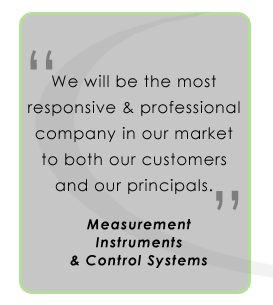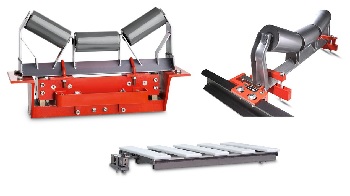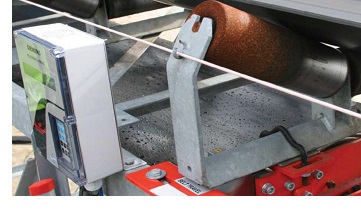|
Siemens Answers: What keeps my belt scale from providing the accuracy I need? | |
|
Before we get into the alignment, let’s talk about the different types of idlers and which are most suitable for a belt scale. Standard trough idlers are made up of three rollers, often called cans, on a frame. The center roller is parallel with the bottom of the idler frame. The other two rollers, called wing rollers, are located on each side of the idler frame and mounted on an angle to turn the edges of the belt up. The wing rollers are available in three angles – 20o, 35o, and 45o – with 35o being the most common trough. All three trough angles are acceptable, but your belt scale may experience slightly reduced accuracy if the idlers have a 45o trough. This is because as the edges of the belt are turned up, it will become more rigid and allow less of the material weight to transfer to the scale. V-roll idlers have a similar effect of making the belt too stiff and should not be used on a belt scale. Because a belt scale requires the idlers to be tightly aligned, wire rope idlers and catenary idlers are not suitable for use. To perform an idler alignment, make sure all the idlers are square to the conveyor frame, equally spaced, and aligned on the same plane. To align the idlers in the same plane, make sure they are the same type, size, and from the same manufacturer. On a single idler scale with trough idlers, three strings are drawn across the idlers being aligned. One string will be pulled across all the idlers being aligned in the center of the belt line. A second string is pulled across the wing rollers on one side, near the top of the wing roller, and the third string should be pulled down the wing roller on the other side. The strings should be drawn tight so there is no sag. The strings can then be used to identify any idlers that are not aligned with the adjacent idler. Each string should lightly touch each roller. If it doesn’t, the low idler should be shimmed until everything is lightly touching.
The belt should make firm contact with all the idler rollers that were aligned. If a belt is too tight or too thick, the belt could rise between the wing rollers and cause additional errors in the belt scale. To ensure the best accuracy, the belt should have contact with all the rollers of the conveyor idlers near the scale. Proper idler alignment, tensioning, and belt thickness will allow good contact with all the idler rollers in the scale area.
When selecting a location for the belt scale, any curves in the conveyor should also be considered. A curve will have a lifting effect on the belt; this will prevent the full material load from transferring to the scale. Belt scales should not be located closer than 40 ft from the last point of a concave curve. If the conveyor has a convex curve, and the scale is located on the infeed end of the conveyor, the scale can be located 20 ft from the last point of the curve. If the scale is on the head pulley side of a conveyor, with a convex curve, the scale must be 40 ft from the last point of the curve. And finally, when considering the best location for the scale, you should look for any conveyor appliances such as belt plows and training idlers. These devices can put unusual forces on the belt and should not be located within 60 ft of a belt scale. Although these are the most common factors that affect a belt scale’s accuracy, every manufacturer will have different requirements. Always consult your belt scale manufacturer for proper installation guidelines. How accurate are your belt scales? | |
|
|



 January 2021, MARIETTA, GA ~
January 2021, MARIETTA, GA ~

 For
additional information or a product recommendation, please contact FLW
Southeast at
For
additional information or a product recommendation, please contact FLW
Southeast at